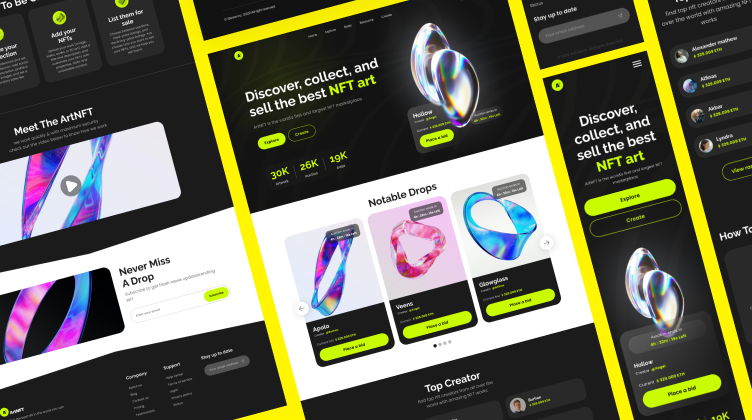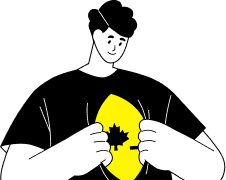Table of Contents
Contact Us
How to Create an NFT Marketplace (Step-by-Step Guide)
BLOG / Web Development 10 May 2023

The global NFT market will be worth around $211 billion by 2030, according to a forecast by Grand View Research. And based on the current NFT market size, the aforementioned number means a CAGR (Compound annual growth rate) of 34.2%.
This fact’s got a plethora of digital geeks into considering the creation of an NFT marketplace.
And the best way to enter an emerging market like this is to develop your own NFT marketplace. This will allow you to have a marketplace where NFT creators and buyers can interact and connect.
That’s not to say it’s sunshine and rainbows, but… there are more pros than cons for the right team and leader!
Right now, there are multiple six-figure or higher NFT marketplaces, such as OpenSea, Rarible, Binance, and so on… You would be surprised to know that OpenSea managed to gain $144.5 million in revenue in Q3 2022 alone!
So, today, we will look at what an NFT marketplace is. And more importantly, how to create an NFT marketplace that can give serious competition to the top players in this space!
What is NFT marketplace?


An NFT marketplace is a digital platform where users can trade non-fungible tokens, also known as NFTs. These platforms are built on blockchain architecture in which a read-only record of NFTs is stored.
For an NFT creator, a marketplace provides a medium where they can list their digital assets such as photographs, illustrations, music, 3D models, etc. Similarly, those interested in buying those NFTs can join the NFT marketplace and buy these digital assets.
If we look back, the first NFT ever created was in 2014, which marked the beginning of web 3.0 activity. The name of that NFT was “Quantum,” and it was made by Kevin McCoy. As per the reports, the Quantum NFT was sold for $1.47 million in 2021!
That’s why we can say that the whole NFT scene gained mainstream attention in 2021. And from this point onward, we saw a lot of stories about how people sold and resold memes for millions of dollars!
There’s no doubt that the NFT market is growing bigger year by year. And there’s no better time than now to create NFT marketplaces.
How to create an NFT marketplace: 8 steps
The exact process of creating an NFT marketplace may differ depending on which features you want to offer in the NFT platform…
Still, the basic steps are usually the same as the ones mentioned below:
1. Choose a niche
Before thinking of NFT marketplace development, take a step back and consider what will make your NFT marketplace special… After all, there are already so many big names, and you would need to be unique & special to stand out from the pop.
One of the ways to achieve this is to determine a specific niche and then build your NFT marketplace around that. This will help you to avoid being too generic & will also attract NFT buyers who are interested in that specific niche.
For example, OpenSea is a broad niche NFT marketplace where you can find all types of digital assets. On the contrary, NBA Top Shot is a niche-centered NFT marketplace that only features NFTs from the NBA.
2. Choose a blockchain technology
After deciding on a niche, the next step in our “how to create an NFT marketplace” guide is choosing a blockchain technology.
You can either create your own blockchain technology from scratch or use existing technology.

Right now, there are a lot of existing blockchain technologies, such as Ethereum, Cardano, Solana, and Polygon. All of these are popular and established technologies that are already used by millions of users. So, if you decide to go that route, you will be enjoying the trust factor that comes with it.
However, integrating these blockchain technologies isn’t something that a team of ordinary developers can do. After all, these technologies are the core of web 3.0 and thus require specialized developers! That’s why you should be ready to invest a minimum of $50,000 to build a basic NFT marketplace.
And last but not least, using these existing blockchain technologies means every transaction carried on your marketplace will incur a cost. In the NFT space, this cost is commonly known as the “Gas Fee.”
3. Choose the market type
Do you want an open NFT marketplace or a closed one?
That’s the next question you will have to answer!
An open NFT marketplace allows multi-token support & thus can attract a wider audience. On the other hand, a closed NFT marketplace only uses a specific proprietary token.
This means users must first convert their cryptocurrencies into that specific proprietary token before using the closed marketplace. If you think about it, this adds another step & can severely limit the appeal of your marketplace.
Most of the popular NFT marketplaces, including OpenSea, operate on an open-market model. This allows OpenSea and other marketplaces to support 150+ different types of crypto tokens!
4. UI/UX design
Once you decide on which blockchain technology to use on the backend and the market type, you can move towards the UI/UX design of your NFT marketplace.
The process of designing a user interface (UI) and user experience (UX) of your NFT marketplace falls under the umbrella of front-end development.
In the NFTs universe, looks matter; that’s why you shouldn’t overlook picking a compelling & unique design!
If your front end doesn’t look appealing to the masses, having great back-end blockchain technology wouldn’t save your marketplace from failing (if it even rises in the first place!).
That’s why when you spend a great deal of effort, money, and time on the back-end development, make sure not to miss the UI/UX design as well!
5. Set commission structure
And here comes the question that will dictate how much money you can make from your NFT marketplace!
Ideally, your commission structure should be market competitive (not too high & not too low). This will allow you to cover the running costs of the marketplace & also to make some money.
Another way is to set your commissions very low or even charge no commissions. In this method, you would be making less money or even receiving a loss, but it would allow you to build a user base quickly.
In a saturated market, such tactics can prove to be really beneficial in securing a market share at an early stage. However, let’s not forget that it also requires deep pockets!
7. Test and deploy
At this stage, both the front-end and back-end portions of your NFT marketplace will be complete. Now, all that’s left is to test and deploy your NFT marketplace app!
Before you deploy the NFT marketplace and open it to the public, it is crucial to test & fix any bugs. The best way to go about it is to launch a limited beta of your marketplace where you can collect user data and spot bugs and inconsistencies that weren’t spotted during the UAT phase.
8. Join a community
Congratulations! Your NFT marketplace is now ready to take the NFT space by storm. The main concern now is to build trust and attract users and investors.
To establish your new marketplace, you will have to go out and market your project to NFT buyers and sellers. To achieve this, you can join relevant crypto communities on Reddit, Discord, and other relevant channels.
Similarly, you can opt for paid marketing campaigns on Google, Facebook, Pinterest, and other platforms to attract users.
Conclusion
The process of creating an NFT marketplace is basically similar to doing any other web 2.0 project. However, the only difference is that you need to integrate blockchain technology in the backend, which can get costly.
And for that, you need a team of experts who understand how Web 3.0 works & more importantly, how to make something that stands out!
So, if you are ready to make something extraordinary, contact our team of superheroes at Canadian Digital Consulting today!





